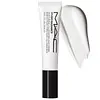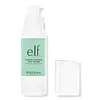What's inside
What's inside
 Key Ingredients
Key Ingredients

 Benefits
Benefits

 Concerns
Concerns

 Ingredients Side-by-side
Ingredients Side-by-side

Water
Skin ConditioningButylene Glycol
HumectantOlea Europaea Fruit Oil
MaskingIsononyl Isononanoate
EmollientSimmondsia Chinensis Seed Oil
EmollientGlycerin
HumectantOctyldodecanol
EmollientHydroxyethyl Acrylate/Sodium Acryloyldimethyl Taurate Copolymer
Emulsion StabilisingPolyglyceryl-2 Triisostearate
EmulsifyingTocopheryl Acetate
AntioxidantSodium Hyaluronate
HumectantSqualane
EmollientHordeum Vulgare Extract
EmollientTriticum Vulgare Germ Extract
Skin ConditioningNiacinamide
SmoothingSorbitol
HumectantTrehalose
HumectantParfum
MaskingDimethicone
EmollientCetyl PEG/PPG-10/1 Dimethicone
EmulsifyingSodium Polyaspartate
HumectantPolymethylsilsesquioxane
Hydroxyethyl Urea
HumectantHdi/PPG/Polycaprolactone Crosspolymer
Octyldodecyl Xyloside
EmulsifyingQuaternium-90 Bentonite
Polysorbate 60
EmulsifyingSodium Chloride
MaskingSilica
AbrasivePropylene Carbonate
SolventIsopropyl Isostearate
EmollientCaprylyl Glycol
EmollientHexylene Glycol
EmulsifyingHydrogenated Polyisobutene
EmollientPEG-30 Dipolyhydroxystearate
EmulsifyingSorbitan Isostearate
EmulsifyingBenzyl Salicylate
PerfumingLimonene
PerfumingLinalool
PerfumingPentaerythrityl Tetra-Di-T-Butyl Hydroxyhydrocinnamate
AntioxidantDisodium EDTA
Phenoxyethanol
PreservativePotassium Sorbate
PreservativeSodium Dehydroacetate
PreservativeWater, Butylene Glycol, Olea Europaea Fruit Oil, Isononyl Isononanoate, Simmondsia Chinensis Seed Oil, Glycerin, Octyldodecanol, Hydroxyethyl Acrylate/Sodium Acryloyldimethyl Taurate Copolymer, Polyglyceryl-2 Triisostearate, Tocopheryl Acetate, Sodium Hyaluronate, Squalane, Hordeum Vulgare Extract, Triticum Vulgare Germ Extract, Niacinamide, Sorbitol, Trehalose, Parfum, Dimethicone, Cetyl PEG/PPG-10/1 Dimethicone, Sodium Polyaspartate, Polymethylsilsesquioxane, Hydroxyethyl Urea, Hdi/PPG/Polycaprolactone Crosspolymer, Octyldodecyl Xyloside, Quaternium-90 Bentonite, Polysorbate 60, Sodium Chloride, Silica, Propylene Carbonate, Isopropyl Isostearate, Caprylyl Glycol, Hexylene Glycol, Hydrogenated Polyisobutene, PEG-30 Dipolyhydroxystearate, Sorbitan Isostearate, Benzyl Salicylate, Limonene, Linalool, Pentaerythrityl Tetra-Di-T-Butyl Hydroxyhydrocinnamate, Disodium EDTA, Phenoxyethanol, Potassium Sorbate, Sodium Dehydroacetate
Salicylic Acid 2%
MaskingWater
Skin ConditioningHydrogenated Polyisobutene
EmollientDimethicone
EmollientButylene Glycol
HumectantPropylene Glycol
HumectantEthoxydiglycol
HumectantGlyceryl Stearate
EmollientPEG-100 Stearate
Magnesium Aluminum Silicate
AbsorbentCetearyl Alcohol
EmollientTriethanolamine
BufferingPolyacrylamide
C13-14 Isoparaffin
EmollientLaureth-7
EmulsifyingStearic Acid
CleansingVp/Hexadecene Copolymer
Tocopheryl Acetate
AntioxidantXanthan Gum
EmulsifyingSilica
AbrasiveDisodium EDTA
Panthenol
Skin ConditioningRosmarinus Officinalis Extract
AntimicrobialThymus Vulgaris Leaf Extract
Skin ProtectingCamellia Sinensis Leaf Extract
AntimicrobialCitrus Limon Fruit Extract
MaskingPhenoxyethanol
PreservativeCaprylyl Glycol
EmollientSalicylic Acid 2%, Water, Hydrogenated Polyisobutene, Dimethicone, Butylene Glycol, Propylene Glycol, Ethoxydiglycol, Glyceryl Stearate, PEG-100 Stearate, Magnesium Aluminum Silicate, Cetearyl Alcohol, Triethanolamine, Polyacrylamide, C13-14 Isoparaffin, Laureth-7, Stearic Acid, Vp/Hexadecene Copolymer, Tocopheryl Acetate, Xanthan Gum, Silica, Disodium EDTA, Panthenol, Rosmarinus Officinalis Extract, Thymus Vulgaris Leaf Extract, Camellia Sinensis Leaf Extract, Citrus Limon Fruit Extract, Phenoxyethanol, Caprylyl Glycol
Ingredients Explained
These ingredients are found in both products.
Ingredients higher up in an ingredient list are typically present in a larger amount.
Butylene Glycol (or BG) is used within cosmetic products for a few different reasons:
Overall, Butylene Glycol is a safe and well-rounded ingredient that works well with other ingredients.
Though this ingredient works well with most skin types, some people with sensitive skin may experience a reaction such as allergic rashes, closed comedones, or itchiness.
Learn more about Butylene GlycolCaprylyl Glycol is a humectant and emollient, meaning it attracts and preserves moisture.
It is a common ingredient in many products, especially those designed to hydrate skin. The primary benefits are retaining moisture, skin softening, and promoting a healthy skin barrier.
Though Caprylyl Glycol is an alcohol derived from fatty acids, it is not the kind that can dry out skin.
This ingredient is also used as a preservative to extend the life of products. It has slight antimicrobial properties.
Learn more about Caprylyl GlycolDimethicone is a type of synthetic silicone created from natural materials such as quartz.
What it does:
Dimethicone comes in different viscosities:
Depending on the viscosity, dimethicone has different properties.
Ingredients lists don't always show which type is used, so we recommend reaching out to the brand if you have questions about the viscosity.
This ingredient is unlikely to cause irritation because it does not get absorbed into skin. However, people with silicone allergies should be careful about using this ingredient.
Note: Dimethicone may contribute to pilling. This is because it is not oil or water soluble, so pilling may occur when layered with products. When mixed with heavy oils in a formula, the outcome is also quite greasy.
Learn more about DimethiconeDisodium EDTA plays a role in making products more stable by aiding other preservatives.
It is a chelating agent, meaning it neutralizes metal ions that may be found in a product.
Disodium EDTA is a salt of edetic acid and is found to be safe in cosmetic ingredients.
Learn more about Disodium EDTAHydrogenated Polyisobutene is a synthetic polymer. Polymers are compounds with high molecular weight. Hydrogenated Polyisobutene is an emollient and texture enhancer.
In one study, Hydrogenated Polyisobutene showed better skin hydration levels than Caprylic/Capric Triglyceride. As an emollient, it helps keep your skin soft and hydrated by trapping moisture in.
Hydrogenated Polyisobutene is often used as a mineral oil replacement.
Learn more about Hydrogenated PolyisobutenePhenoxyethanol is a preservative that has germicide, antimicrobial, and aromatic properties. Studies show that phenoxyethanol can prevent microbial growth. By itself, it has a scent that is similar to that of a rose.
It's often used in formulations along with Caprylyl Glycol to preserve the shelf life of products.
Silica, also known as silicon dioxide, is a naturally occurring mineral. It is used as a fine, spherical, and porous powder in cosmetics.
Though it has exfoliant properties, the function of silica varies depending on the product.
The unique structure of silica enhances the spreadability and adds smoothness, making it a great texture enhancer.
It is also used as an active carrier, emulsifier, and mattifier due to its ability to absorb excess oil.
In some products, tiny microneedles called spicules are made from silica or hydrolyzed sponge. When you rub them in, they lightly polish away dead skin layers and enhance the penetration of active ingredients.
Learn more about SilicaTocopheryl Acetate is AKA Vitamin E. It is an antioxidant and protects your skin from free radicals. Free radicals damage the skin by breaking down collagen.
One study found using Tocopheryl Acetate with Vitamin C decreased the number of sunburned cells.
Tocopheryl Acetate is commonly found in both skincare and dietary supplements.
Learn more about Tocopheryl AcetateWater. It's the most common cosmetic ingredient of all. You'll usually see it at the top of ingredient lists, meaning that it makes up the largest part of the product.
So why is it so popular? Water most often acts as a solvent - this means that it helps dissolve other ingredients into the formulation.
You'll also recognize water as that liquid we all need to stay alive. If you see this, drink a glass of water. Stay hydrated!
Learn more about Water